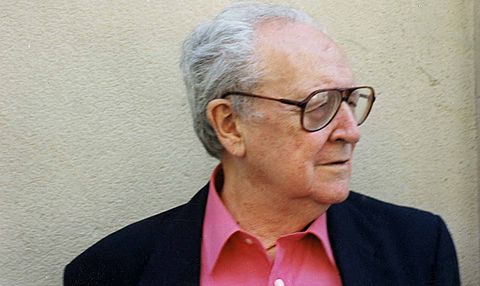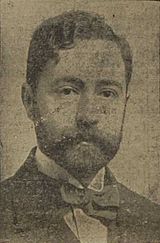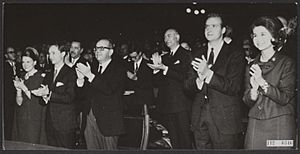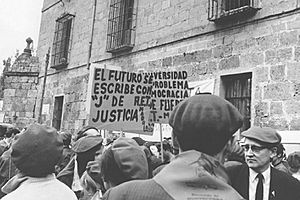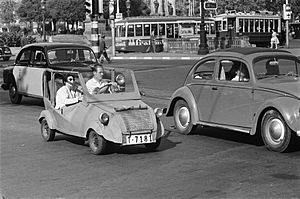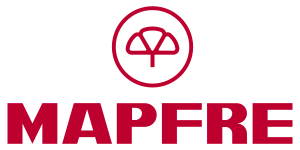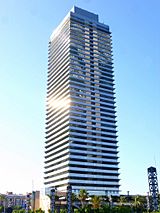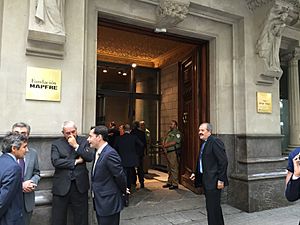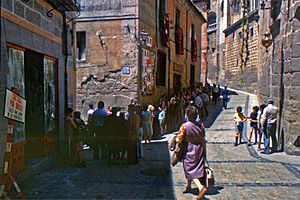Ignacio Hernando de Larramendi y Montiano facts for kids
Quick facts for kids
Ignacio Hernando de Larramendi y Montiano
|
|
|---|---|
|
|
|
| Born |
Ignacio Hernando de Larramendi y Montiano
1921 |
| Died | 2001 (aged 79–80) Madrid, Spain
|
| Nationality | Spanish |
| Occupation | Business manager |
| Known for | Entrepreneur |
| Political party | Carlism |
Ignacio Hernando de Larramendi y Montiano (1921–2001) was an important Spanish businessman, a Carlist activist, and a writer. He led the insurance company MAPFRE for a long time. Many people consider him one of the most influential Spanish businessmen of the 20th century.
Larramendi was also known for supporting and organizing many projects related to Hispanic culture, especially in Latin America. He was briefly part of the Carlist leadership. However, he is better known for promoting Traditionalist ideas and heritage.
Contents
Family and Early Life
Ignacio's family on both his mother's and father's sides were from the Basque region of Spain. His paternal grandfather, Mariano Hernando, was an art dealer. Ignacio's father, Luis Hernando de Larramendi (1882–1957), was a lawyer in Madrid. He was also a Carlist activist. Carlists supported a different branch of the royal family for the Spanish throne.
Ignacio's father was interested in social issues. He passed this interest on to his sons. Ignacio's mother, María de Montiano y Uriarte (1886–1976), was from a noble Basque family.
Ignacio was one of nine children. They were all raised in a very Catholic home in Madrid. He started school at Colegio de Nuestra Señora de Pilar in 1932. However, the Spanish Civil War began before he finished.
During the war, his family was on holiday in San Sebastián. His father went to the Nationalist zone. Ignacio continued his schooling in San Sebastián until 1937. Then, he joined a Carlist youth group called Requeté. He served as a prison guard for a short time. Later, he joined a different Requeté unit and traveled with them through Catalonia and Extremadura.
In 1939, Larramendi began studying law in Madrid. He graduated in 1941. He first wanted to be a lawyer. But in 1944, he started working at Dirección General de Seguros, a government body that regulated insurance.
In 1950, he married Lourdes Martínez Gutiérrez (1924–2015). They had nine children. Their son, Ramón Hernando de Larramendi, is a famous polar explorer. Another son, Luis, followed his father into business and politics. Their daughter, Margarita, is a poet and language expert.
Early Political Activities
Ignacio was involved in politics from a young age. At 10, he handed out Carlist leaflets for his father in 1931. During the Civil War, he joined a Carlist student group. After returning to Madrid, he became a very active leader in this group.
He and his friends, like Rafael Gambra, held small protests against the Franco government. In 1942, he was even detained for a short time. They also participated in Academia Vázquez de Mella. This was a private school with Carlist ideas. This experience made Larramendi more interested in social issues and the cultural side of Traditionalism.
In the early 1950s, Larramendi became known as a young, loyal Carlist activist. He strongly opposed Franco's government. He supported the Borbón-Parmas as the rightful royal family. He even started his own publishing house, Editorial Cálamo, which published Traditionalist books.
Larramendi was part of a group that wanted the Carlist movement to be more active against Franco. He briefly joined the party's leadership. However, he resigned after a few months. This was because the new leaders wanted to cooperate with Franco, which Larramendi disagreed with.
Later Political Involvement
Larramendi continued to be involved in Carlist events. In 1957, he attended the annual Montejurra gathering. Here, the Carlist heir, Don Carlos Hugo, was introduced. Larramendi was cautious about the prince, fearing he might try to work with Franco's government.
In the late 1950s, Larramendi worked with Carlist groups in Madrid. He had different opinions from some of the prince's close advisors. By the mid-1960s, his involvement in party politics became less active. This was especially true after his friends, Gambra and Elías, left the Carlist party. They felt the party was moving away from its original ideas.
As the Carlist movement became more radical, Larramendi worried about its new Marxist direction. However, he remained loyal to the Carlist royal family. In 1969, he even hosted the Carlist king, Don Javier, at his home in Madrid.
In 1970, Larramendi attended a meeting in Arbonne. This meeting aimed to find a compromise between different Carlist groups. Larramendi tried to be a peacemaker. He said that if the party wanted to embrace socialist ideas, its members should act, not just talk. He meant that he, as a business leader, would start by doing so.
However, he soon disagreed with the new direction of the Carlist party. In 1975, he wrote a letter to King Don Javier. He demanded that the king confirm the original Traditionalist principles. After Franco's death, Larramendi stopped being active in politics.
MAPFRE: From Struggle to Success
After spending some months in London, Larramendi worked for a state insurance regulator. In 1955, he joined MAPFRE. It was a medium-sized private insurance company. At that time, MAPFRE was almost bankrupt. As the director general, Larramendi was given the job of fixing the company.
He worked to pay back debts and made the company's operations more efficient. By the late 1950s, MAPFRE was making a profit again. Larramendi then started planning for new growth.
He created MAPFRE Mutua Patronal de Accidentes de Trabajo for health insurance. In the early 1960s, he developed a financial branch. This combined insurance with credit for people buying cars. This plan worked very well as the Spanish car market grew quickly.
Larramendi also created investment companies like Muinsa. These companies helped MAPFRE invest money. By the late 1960s, the company started changing some of its structures into joint-stock organizations.
In 1970, Larramendi led a major reorganization of MAPFRE. The company was divided into different groups. These groups focused on specific areas like transport, business, and consumer insurance. This structure allowed them to share services but still work independently. By the early 1970s, MAPFRE became the leader in car insurance.
Larramendi's leadership was so strong that when he disagreed with the chairman of the board in 1972, the chairman resigned. In 1975, Larramendi's official title changed. But he remained the main leader of the company.
The mid-1970s was a tough time for the world economy, including Spain and MAPFRE. Larramendi responded with another reorganization in 1978. He created Corporación MAPFRE as a holding company. This allowed MAPFRE to control its smaller companies.
In 1983, MAPFRE became the overall market leader in Spanish insurance. This was thanks to Larramendi's smart strategies.
MAPFRE: Growing at Home and Abroad
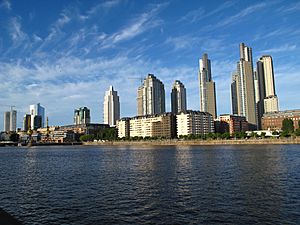
In 1969, Larramendi decided that MAPFRE should expand beyond Spain. He focused on Latin America. In the early 1970s, the company started public relations campaigns there. Larramendi himself traveled around the continent. He believed Argentina was a promising market and Colombia was very "Spanish."
In the late 1970s, MAPFRE tried different ways to expand. They set up MAPFRE Internacional in 1976 and entered many South American markets directly. They also formed partnerships with European companies.
The most successful strategy was buying local companies. By the late 1980s, MAPFRE became a major player in Latin America. Their quick help after the 1985 Mexico earthquake also earned them respect. By 1998, MAPFRE was the leader in re-insurance in Latin America. They were also the top foreign insurance company there.
MAPFRE did not grow much in Europe during Larramendi's time. They decided they couldn't compete with larger European companies. They also considered entering Japan, but those plans were scaled back.

In 1985, Larramendi changed his role. He became the chairman of the institutional control commission. But he still guided the company. In the late 1980s, he helped design a new plan called Sistema MAPFRE 92. This plan made the company a loose group of businesses. Each part had a lot of freedom, similar to Japanese business models.
In 1990, MAPFRE also created Banco MAPFRE, a bank. The same year, at age 70, Larramendi retired from most of his roles. He followed the rules he had set for others. He left MAPFRE as a very large company with many offices and employees.
MAPFRE's Keys to Success
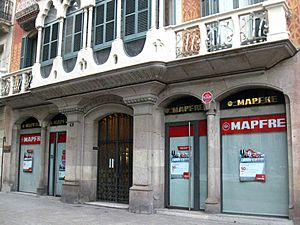
Larramendi is considered one of Spain's most influential managers of the 20th century. He often said his success came from how he managed people. He created a special code of conduct for employees. This code promoted respect, honesty, and trust. Employees who followed it were called "mafristas."
He also believed in giving employees responsibility and letting them be creative. This idea is now called "emergent change" in business. It means ideas can come from anywhere, not just from the top.
Business experts agree that Larramendi's focus on people was key. He brought modern HR practices from Britain and the US to Spain. This included career paths, training, and mentoring. He also preferred to hire university graduates.
Larramendi cared about all people involved with the company. This included employees, customers, and suppliers, not just the owners. He also used a decentralized management style. This meant regional offices had more control. This helped the company work more efficiently. He is also known for "specialized diversification." This allowed MAPFRE to focus on customers and share services.
Larramendi also brought new ideas to the insurance and financial markets in Spain. He introduced new products like travel assistance for drivers and home assistance programs. He also focused on risk management. He wanted to offer customers a "one-stop financial shopping" experience.
He was obsessed with having accurate information. This led MAPFRE to be a leader in technology. It was one of the first companies in Spain to use telex and digital data storage.
MAPFRE's success in Latin America is a great example of smart business strategy. Larramendi used the company's strengths, chosen locations, and internal processes to succeed. He also understood the importance of cultural closeness. This helped MAPFRE do better than other foreign competitors. He received many awards for his business achievements.
Supporting Culture and History
Larramendi believed in corporate social responsibility. This means businesses should help society. In 1975, he started Fundación MAPFRE. This foundation promoted safety at work and helped people recover from accidents. Later, he created other MAPFRE foundations. These focused on culture, studies, and medicine.
After he retired, Larramendi dedicated most of his time to these foundations. He focused especially on Fundación MAPFRE América. This foundation's main project was Colecciones Mapfre 1492. This was a huge collection of publications about different topics related to Latin America. These books were given to institutions across Latin America. The foundation also re-published historical documents and supported international conferences.
In the 1990s, Larramendi helped create Fundación Histórica Tavera. This foundation worked to protect old books and documents from Spain, Portugal, and Latin America. They focused on digitizing old texts. They also helped catalog and preserve archives from different institutions.
Larramendi also supported projects related to Carlism. He gave money to Carlist publications. In 1986, he set up Fundación Hernando de Larramendi, named after his father. Today, it is called Fundación Ignacio Larramendi. Its goal is to promote Catholic values and support scientific research. It also studies the history of Carlism.
The foundation publishes digital collections of Traditionalist thinkers. It also publishes scholarly and literary works. It gives out an award for historical books about Carlism. The foundation also has a website with many digitalized works and old newspaper clippings.
The Spanish government recognized Larramendi's cultural work. He received important honors like the Encomienda de Isabel la Católica (1996) and the Gran Cruz de la Orden del Mérito Civil (1998).
As an Author
Larramendi wrote 8 books and about 50 articles. Most of his writings were about business. His book Manual básico de seguros (1982) is a key example. However, his books on society and politics are often considered more interesting.
His book Tres claves de la vida inglesa (1951) was based on his time in London. It praised the British social and state system. He saw it as a good mix of efficient economy and traditional values. He admired Britain's sense of continuity.
In 1977, Larramendi published Anotaciones de sociopolítica independiente. This book discussed Spain after Franco's rule. It proposed a social-Catholic vision for the country. He believed Spain should integrate with Western Europe. He also worried about the spread of Communism in Spain.
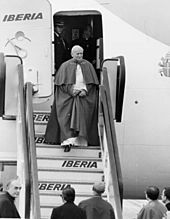
In 1992, Larramendi published Utopía de la Nueva América. This book explored his interest in the Americas. He believed that Latin America and Anglo-America would merge into a new cultural entity.
In the mid-1990s, he started his biggest writing project. This was a series of books meant to address global problems and issues in Spain. He wanted to propose a "reform of the Spanish state." The series ended up being three books:
- Crisis de sociedad: reflexiones para el siglo XXI (1995)
- Panorama para una reforma del estado (1996)
- Bienestar solidario (1998)
These books discussed how to redefine public institutions based on Christian values. Crisis was more historical. Panorama looked at state operations. Bienestar focused on public structures like education and insurance.
His last and perhaps most popular book was Así se hizo MAPFRE (2000). This book told the story of the MAPFRE company. It also included details about his personal life and the business world of his time.
See also
 In Spanish: Ignacio Hernando de Larramendi para niños
In Spanish: Ignacio Hernando de Larramendi para niños
- Carlism
- Mapfre
- Hispanidad
- Luis Hernando de Larramendi y Ruiz


